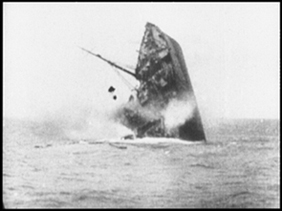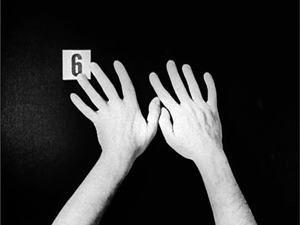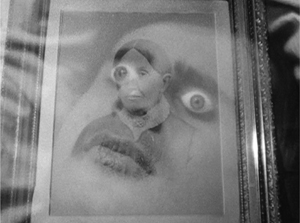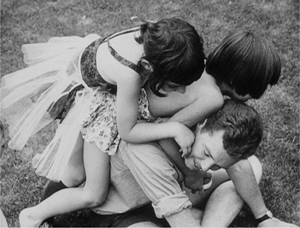"Worthwhile Insanity": On Collage Filmmaking and Arthur Lipsett, An Interview with Bruce Conner
By Amelia Does
The late Bruce Conner was a visionary artist and consistent fixture of the San Francisco counter-culture up until his passing in July 2008. Well-known on the West Coast for his collage sculptures before turning to film assemblage, Conner emerged in the 1960s as a major avant-garde filmmaker. His early films A Movie (1958), a montage of found materials culled from various sources including war documentaries, nudie flicks, old westerns and disaster footage, assembled in a rapid collage to Respighi’s “Pines of Rome,” Cosmic Ray (1961), a four-minute quick mix of self-shot and sourced footage set to Ray Charles’ “What’d I Say,” and Report (1963-67), a meditative deconstruction of the JFK assassination, appeared during the development and explosive expansion of the post-Maya Deren underground film movement, and helped to define and shape an entire genre of experimental screen practice: the found-footage film.
I interviewed Conner over the phone while gathering information about the Canadian experimental filmmaker Arthur Lipsett in the winter of 2005. I wanted to speak to him because Lipsett and Conner both made groundbreaking short found-footage films during the late-50s and early-60s. Their work was frequently in competition taking top prizes in film festivals such as Ann Arbor and Palo Alto, among others. Conversely, Lipsett’s films were funded and created in a film institution, while Conner’s were created out of pocket with whatever scraps and supplies he could get his hands on. During the interview I was surprised to learn that Conner had met Lipsett during a visit to the National Film Board of Canada in Montreal in the early-60s. In a subsequent conversation, Conner asked why I wanted to interview him about Lipsett. His health was failing at the time and he seemed not to see the connection between himself and this Canadian counterpart who had died 20 years prior. I pointed out that they both made films of a similar quality and style, nearly simultaneously, but at opposite sides of the continent. His last words to me were, “I guess we did have something in common.”
* * *
AD: Can you begin by telling me about your first filmmaking experience?
BC: When I decided to make my first film [A Movie] I discovered how difficult it was to get the footage. I had virtually no money. I was working as an usher in a movie theatre for a dollar an hour. My wife was working with me at a hot dog stand. It’s really a poverty film: it was made from footage from newsreels, documentaries, sports events, movies, everything. They were films condensed down into two-and-a-half minute silent reels, which were actually cheaper than buying black and white film and processing and printing it. It cost about $3 for a 100-foot reel; to shoot film it would have cost about $13 bucks per roll, and I didn’t have a camera. So this was the most economical way of getting material. I borrowed a camera to shoot the titles and that’s how I made the film.
AD: How did people initially react to A Movie?
BC: The first time I think I showed it was in a film history class, at what’s now called the San Francisco Art Institute. Nobody was teaching filmmaking in those days, in the States or anywhere. I was running a film society with Larry Schwartz called Camera Obscura in San Francisco; this was the only way I could set up and see the films I wanted to see. I wanted to splice a film of a virtually nude woman putting her stockings on into a countdown leader and then show it, and Larry was very upset and quit the film organization. So I realized I would have to make my own movies and I would use that.
 |
 |
A Movie / Bruce Conner, courtesy of Dennis Mohr and the Estate of Bruce Conner
I edited A Movie in about two weeks. [Larry] showed me how to edit in about 30 minutes. I would splice the film together, put it on the projector, turn on the radio and play some music with it, whatever it happened to be. Finally when I had it organized I would play a record and pick up and drop the needle. It is definitely a low-grade poverty film.
The first public showing, actually the first non-public showing, would probably have been in this film class. I would occasionally drop in to see what kind of films they were showing. This was a professional perk that I had since I was running the only film society in town. So I brought my film into the classroom and I put it on the projector, and played a record, dropping down the needle like I described earlier. At the end of it there was a discussion with the students and a couple of sit-ins, and a man who taught photography, who was really teed off. He didn’t like it at all. He said, “You didn’t do anything! All you did was paste a whole bunch of pictures together and play a record with it! It doesn’t mean anything! It’s just ridiculous. This isn’t a movie. It isn’t worth the time.”
We were going back and forth, and finally he said, “Just what the hell does this thing mean? What are you doing here?” I knew I wouldn’t get anyplace with that kind of conversation, so I decided to push it to the outer limit, and said, “Well, first of all, it’s built on seven mystic levels…” which immediately sent him into the stratosphere and he began by waving his arms, he practically knocked the chair over, and he stomped around, and said, “Goddamn! Who likes this crap? This is ridiculous!” And he stomped out the door. So that was one instance.
The second, which was a more public event, was a solo exhibition of collages, paintings, drawings, and other work at the East/West Gallery in San Francisco. I set up the same arrangement, but unfortunately the fuses in the building couldn’t handle the wattage of the projector. We blew the fuses about four or five times, so the movie was very episodic! I would play the music and the movie would start, and the lights would go out, and the music would stop, and then the fuses would go in, and I would have to stop and start the whole thing over again. Fortunately it wasn’t totally pitch black, because I decided to have a searchlight for the opening of my show in the street. This was in 1958; it was probably the first time a searchlight was used for an art show. This is down in an area of San Francisco near the Bay that is traditionally foggy. And it was very foggy, so the light was glaring out into the fog and illuminating the whole block. It was very impressive. People came in thinking it was a new bar, and we were giving away free glasses of wine, so there were people standing out on the sidewalk drinking wine. Those were the previews.
AD: I was wondering if you could talk about Arthur Lipsett and compare some of the films. Do you remember seeing Very Nice, Very Nice (1961)?
 |
 |
 |
 |
Clockwise from top left: Fluxes, Free Fall, A Trip Down Memory Lane, Very Nice, Very Nice / Arthur Lipsett, courtesy of the National Film Board of Canada
BC: Yes, I remember seeing Very Nice, Very Nice, and some of Lipsett’s films in 1964-65 in Montreal. I met him only briefly–for no more than about ten minutes–and I thought he was a rather intense person and very much in a critical frame of mind. He seemed to have bitterness as well at times. But otherwise he seemed a nice person to me.
AD: Did he tell you that he had seen your works?
BC: I’m sure he had seen my films. He was headed in the same sort of direction that I was. Looking over his films in general, I see a number of things that could be derivative from my films. A Movie and Cosmic Ray, which I completed in 1961, were totally unique films and nobody had made anything quite like them before. So when I saw more films like mine following that period, that use some of the same techniques, I could recognize the films as being like my films.
Many times I felt it difficult to recognize if somebody might be making films like mine, whereas another person might think so. But there were certain technical aspects in the way the films were made that became noteworthy: [using material] shot by other people, movies that are part of the [everyday] environment–documentaries, feature films, travelogues, sports films, all sorts of material–and assembling them sort of like a collage, not in a perfectly logical manner, dissertation, story form, etc, but using them in a number of different ways–for instance, a poetic manner–creating relations that might have to do with form, images, and perhaps a general context.
AD: Do you remember seeing Very Nice, Very Nice and being struck by the fact that it was made up of a lot of photos?
BC: Well, I’ve seen people using photographs before. He [Lipsett] used a lot of various filming techniques like dissolves, where one image merges with another image, sort of like that kind of thing people do on computers now with different images, merging them together. You can see that sort of transformation. I thought we had some kind of commonality in terms of themes: anti-war, anti-Bomb.
Prior to A Movie in 1958, I don’t think people used black leader as a film element except to fade-out; if the screen went black it was to indicate an accident. So to use that for a purpose in A Movie was very unique at that time, as well as making the film out of disparate elements. Also, utilizing the character of film itself, the structure and form of it, its scratches and flares, and differences from one print to another–usually these were considered to be defects, but I was using these as tools, as effects! I don’t know if this was entirely all my invention; people were becoming more and more concerned with film and using characteristics of film that were not considered professional.
Arthur used a little bit of that but not much, due to the fact that he was using film footage or clips that were in much better condition than mine. He had access to more pristine material at the National Film Board. Of course myself and other filmmakers were using 16mm and 8mm, and as filmmakers in the United States we were quite envious of a government-sponsored organization like the Film Board that would sponsor and encourage the kind of films that Arthur and others were making at that time. In a way there is a little bit of contrast between my films and Arthur’s because of his access to technology and expertise and funding. I had to pay for everything that I did. I paid for everything I made and the items personally. So you’ll see splice marks, and the material that I spliced was not copied into work prints, and every time I would make a splice, I would lose a picture, and running it through the projector would produce scratches. But I decided that this was inevitable, like antiquing furniture, or antiquing collected patinas, or a Chinese bronze–as I discovered, it’s the character of the film–it varies from perfect even when it’s a brand new print, projected for the first time. The presentation is always variable.
I also tried to conform my images to music. In a couple of cases there were words, like in my film Report, about the assassination of President Kennedy, but my films were more like visual mimes or performances that used music to hold them together, creating a visual and oral dance.
The unique thing about Arthur’s work, and what is interesting to me, because I was getting involved with using “concrete” electronic or experimental music at that time (in San Francisco and Massachusetts in 1965), and I had myself purposely taken my money from the Ford Foundation grant for filmmaking–a windfall from 1964–and decided to spend all the money on doing sound recordings, editing, and that type of work. Arthur was doing more sound editing and creating new relationships between sound and picture.
AD: So you liked his films?
BC: Well, I was interested, since that is where I was going at the time. However, I abandoned that direction after my Ford Foundation grant. I decided that I’d ruin my reputation as a filmmaker if I used one of these sound collages in a film that I hoped would do that–a notorious film that would create riots and possibly destroy it.
Now, one point where I think Arthur’s films [diverge] with mine, is of course the sound editing, and also his predilections toward using a lot of Oriental imagery, Asian imagery, Asian religion, Asian politics, Asian performance. I don’t think I use as much. Another point is that Arthur would make much longer films than I would. My films were ten seconds, three minutes–the longest film I ever made by 1976 was thirteen minutes. Most of them were around three or four minutes long.
AD: Is there a reason that you return to collage filmmaking periodically in your career?
BC: Well, economically. I can’t afford to make films very often. And I do all the work myself, so I have to put everything else on the sidelines [when I’m making films]. There’s no way of making any money in this, though, so if I’m making a living, I have to do that [filmmaking] some other way. I’m also into exhibiting other artists.
When I make films, it’s because it’s an appropriate medium for me at that moment, or there’s an interest that I feel I have to work at through film. I don’t just make them for myself–I figure I have to if I am going to be producer, writer, director, cameraperson, editor, and distributor of these films, for my entire life. I usually haven’t made films that I don’t expect to see again and again. It’s not like doing a drawing or painting: you exhibit it and that’s it. They [films] do have a longer life.
AD: I feel that Arthur Lipsett could have improved some of his work, but also accessed something great in a perfect form of his own expression. Do you feel that artists do that sort of… when they access their truest form of expression?
BC: Well, I think that people do something great depending on your definition of “great.” [Laughs.]
AD: I feel that some people are lucky that they find what is true to their own lives to freshen up their will or spirit.
BC: If that’s what people value and consider great then–I can’t get into discussions about what is great. Material that was considered absolutely great in the past is now so obscure and uninteresting that nobody will have anything to do with it. We are always involved with our contemporary judgment. You know, it’s nice to have certain constant principles in making various objects and talking about them but it’s deceptive if you start presupposing that they are universal principles.
AD: I was speaking more from a personal view about an artist. Does a true expression happen all the time?
BC: Well, hopefully it happens all the time.
AD: Are you surprised that Arthur’s work is getting more recognition?
BC: Well, I am surprised that anyone is paying attention. [Laughs.] There are so many works and films from the past that have disappeared so quickly, and there are so many that go through the time or period without receiving much attention. I’ve run into people who have refused to listen to old music recordings, people who have refused to watch old black and white movies, because they’re old, and they’re not stereo sound and widescreen and have all the things that are considered very important now. I channel my views–my stance is being outside what is in fashion at the time, all the time. And I would like to feel that a rationale for preserving material and still showing it over a period of time–I make an assumption that time is on my side.
AD: Did you ever make any plans for your film projects?
BC: Very, very, very seldom. The only time I did was when I applied for the Ford Foundation grant and did nothing but fantasize about films that I had no intention of making. And the only one that came close to it was: I did a whole bunch of homework to try to find footage of the first Atomic Bomb tests in Bikini Atoll in 1946. I tracked it all down and found where it was and then made a proposal for a grant, in which I described the film that ended up being Crossroads (1976). There would be no narration; it would use the same event over and over to music or sound effects. I expected it was going to be a very short film with lots of fast cutting but when I actually looked at the footage–I found shots at the National Archives of [Motion Picture Film] that would start running and the bomb would go off and it would run for eight or nine minutes. So [Crossroads] ended up being 37 minutes long, with very long takes of the same event, and music and sound–you see nobody on screen at all, there’s no text predisposing you one way or another. I think [that film] was probably the only one that was going to be close to what it was [on paper]. But I still felt that what I proposed left me plenty of leeway with sound effects and music and how I would organize them in the film and in the context that I wanted to.
AD: Is there anything else that you want to add?
BC: Well, I had heard about Arthur going through the streets with a camera with no film in it, and that he was very eccentric. You know, what he was doing has now become almost an academic cliché.
AD: What do you mean?
BC: The type of thing called performance art. It’s got to the point where, if you really want some money to do something, to get grants to do environments, performance pieces, etc, etc–hopefully with a lot of television sets around–that seems to be what funding organizations put out money for. It’s almost like a hobby-craft activity, where somebody says, Oh, I want to do this thing where I am wearing a heavy overcoat and filming with a camera that has no film in it, and maybe they would explain why they would want to do this, and why people would react to this on the street.
It’s hard to verbalize this sort of thing when you don’t have the language to be able to do so. What I’m talking about now is something that I wouldn’t have been able to talk about in the 1960s. For one thing, I was doing work before there were names for it: conceptual, environmental, assemblage performance pieces, etc, etc. We didn’t have any terms for these. So instead, people related to it as crazy. And people who were doing it didn’t necessarily have a way to explain what it was either, and I wouldn’t be able to!
I think the difference between socially unacceptable behavior and socially acceptable behavior is whatever kind of insanity that the current society and culture considers to be worthwhile, and as long as you fit in there you can continue [to act] absolutely out-of-your-mind, which seems to be the case too many times. [Slight laughter.] I got to go.
ABOUT THE AUTHOR
Amelia Does began researching the biography of the Canadian filmmaker Arthur Lipsett while studying at the University of Western Ontario. She was consulting producer for Remembering Arthur, a feature documentary on Lipsett which opened at the Toronto International Film Festival in 2006.
INCITE Journal of Experimental Media
Counter-Archive
